Built for farm operators and agribusiness leaders, AI-powered tools for agriculture help surface risks earlier, improve planning accuracy, and support confident decisions across farm operations. The focus is on practical adoption, reliable insights, and measurable operational impact.










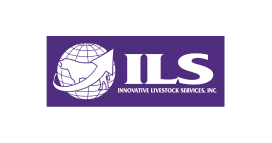

















Harness artificial intelligence for agriculture to automate decisions, forecast risks early, and respond in real time across crop and livestock systems.
AI automates repetitive tasks and standardizes actions across fields, barns, and supply points, enabling teams to execute faster, with fewer errors, and scale operations without added complexity.
By analyzing historical and real-time data, AI uncovers early warning signs in crops, herds, and infrastructure, allowing managers to take timely action and prevent avoidable losses before they occur.
AI models identify underperforming inputs, delayed activities, or inefficiencies across systems. It helps farms reduce input waste and labor costs while maintaining or improving yield quality.
AI helps direct labor, water, feed, and treatments exactly where and when they’re most needed, ensuring every resource delivers measurable value instead of being spread thin or wasted.
Live data from sensors, equipment, and AI models creates a unified, real-time view of operations, so teams can react instantly to issues, reduce downtime, and make confident decisions in the moment.

Health events, feed efficiency, and reproduction outcomes are too costly to manage reactively. AI in livestock farming helps teams detect risks earlier, improve day-to-day decisions, and run healthier, more predictable livestock operations at scale.
Behavior and intake signals feed AI livestock health monitoring to flag early health shifts. Teams act sooner on at-risk animals, reducing delays and performance loss.
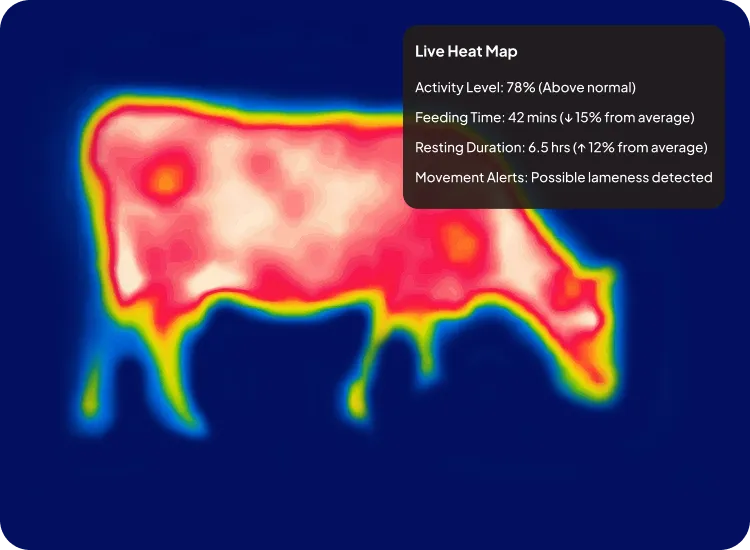
Risk patterns across symptoms and history support AI in livestock management for earlier disease detection. Managers isolate faster and track recoveries to prevent repeat outbreaks.
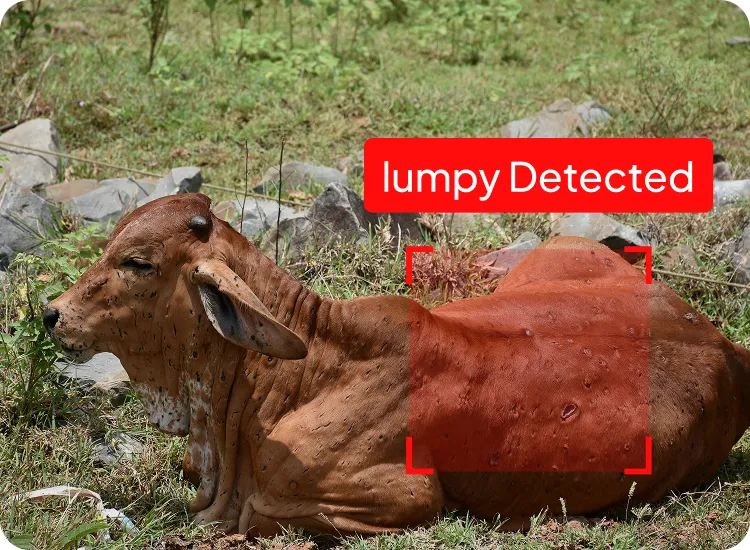
Forage availability and herd demand inform AI in livestock farming to optimize rotations. Pastures recover better while animals gain consistency through planned movement and utilization.
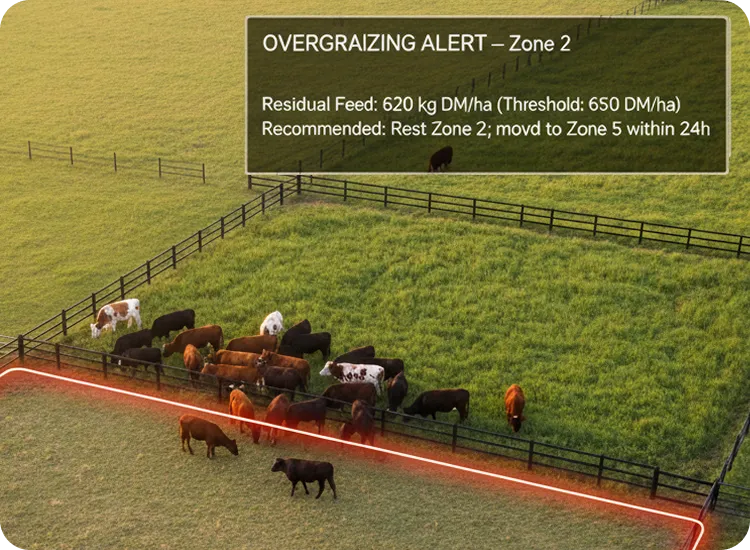
Nutrient targets and ingredient constraints enable AI in cattle farming to balance rations precisely. Producers improve feed efficiency and stabilize production by reducing variation.
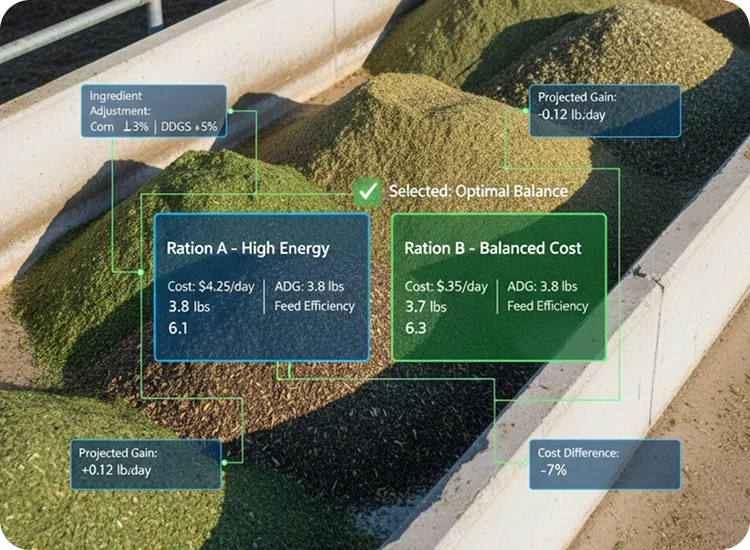
Computer vision automates counting through livestock monitoring across pens and pastures. Inventory stays accurate for planning and audits, with fewer manual checks.
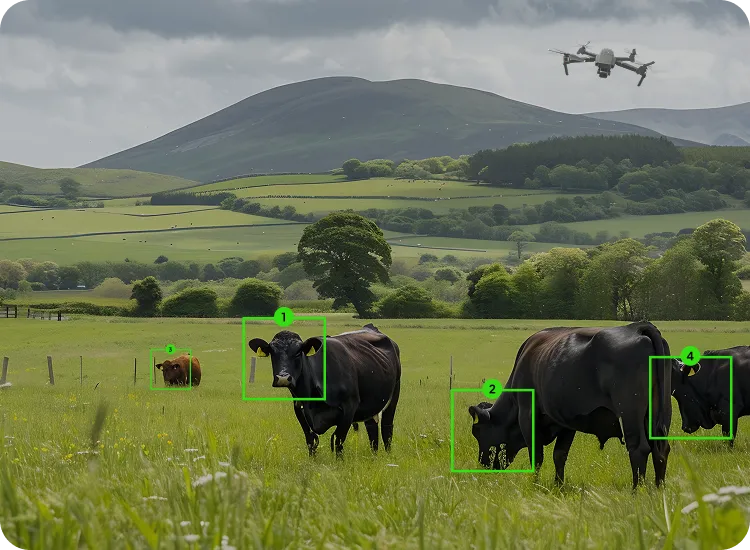
Reproductive records and cycle timing drive AI in livestock management to improve breeding decisions. Teams reduce missed windows and lift conception outcomes with clearer planning.

Intake patterns and growth targets apply AI in cattle farming to optimize feeding plans for feedlots. Consistency improves with deviation alerts and cost-to-gain insights.
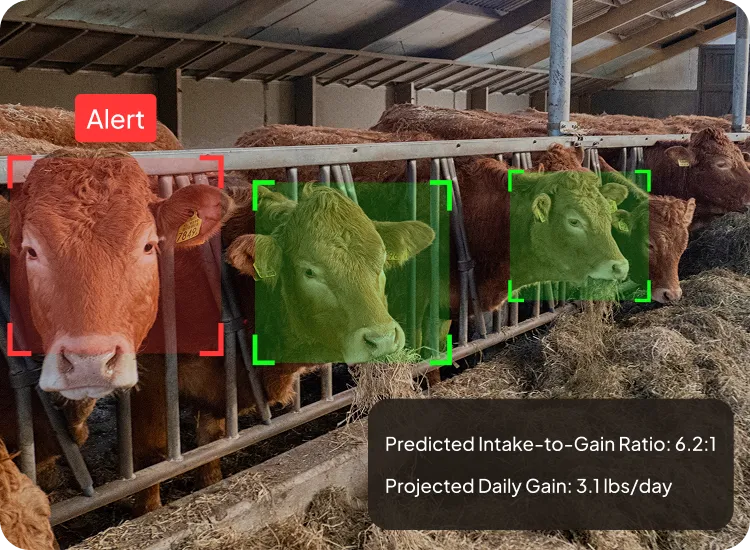
Modern growers need earlier signals and clearer priorities across every field and block. Our AI crop monitoring solutions help detect issues sooner, optimize interventions, and improve operational consistency from pre-season planning through harvest.
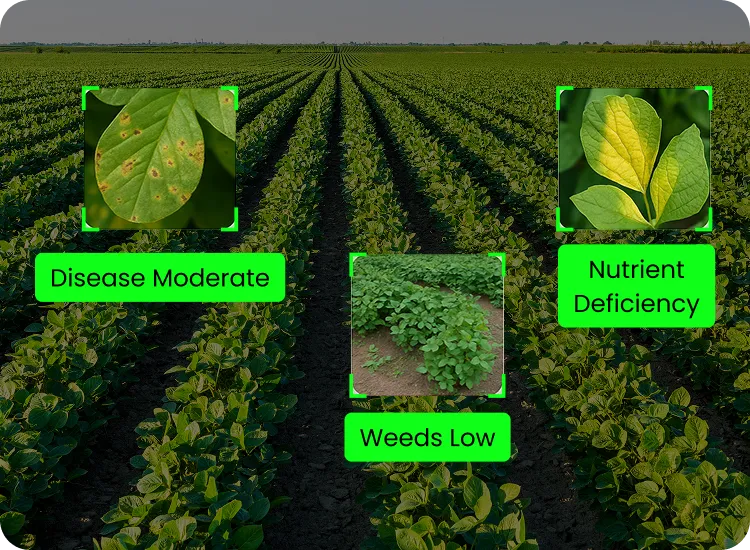
Remote imagery models enable AI for remote crop sensing to flag variability fast. Scouting teams get prioritized zones to inspect first, reducing wasted time.

Image-led analytics deliver AI-powered crop monitoring that flags early disease patterns. Teams can target scouting and treatment sooner, limiting spread and protecting yield.
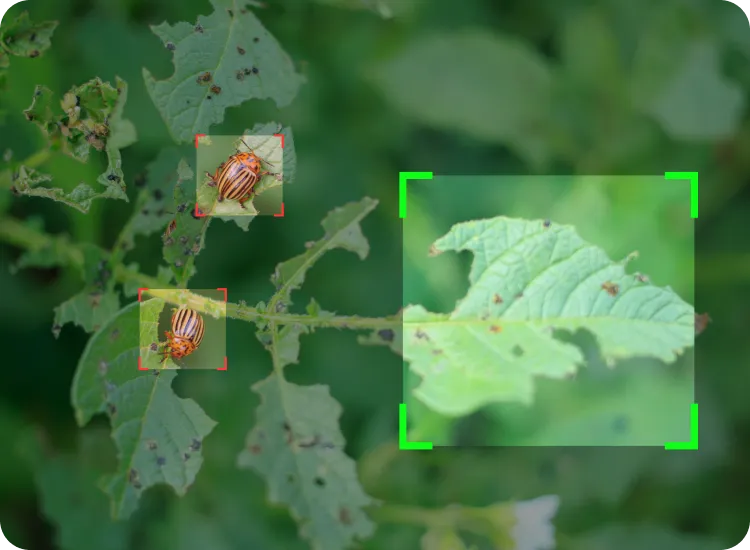
Predictive signals and observations use AI tools for agriculture to anticipate pest pressure. Managers prioritize hotspots and time interventions, reducing damage and input waste.

Field conditions and crop demand feed an AI smart farm irrigation optimizer for scheduling. Teams reduce overwatering and protect performance with alerts when delivery deviates.

Readiness signals and historical outcomes support AI for crop prediction to time harvest more accurately. Crews and equipment align earlier, reducing quality loss from delays.
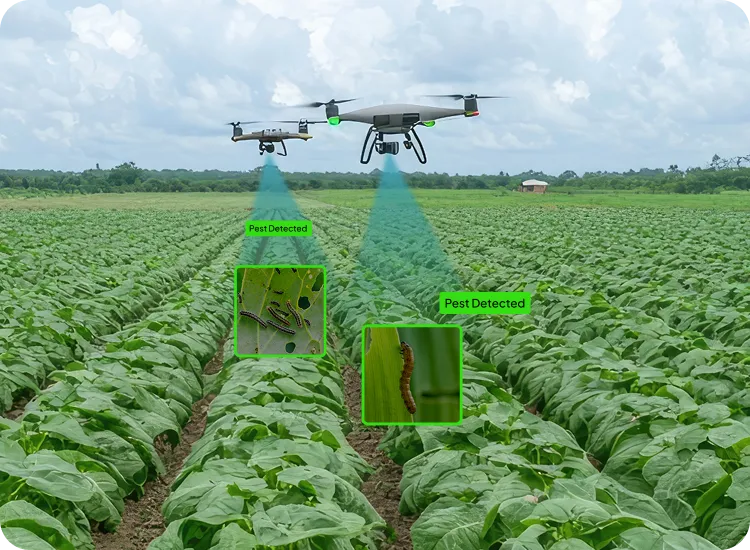
Unified crop records and input data create a dependable base for AI for farm management. Clean datasets improve forecasting reliability and audit-ready reporting across seasons.
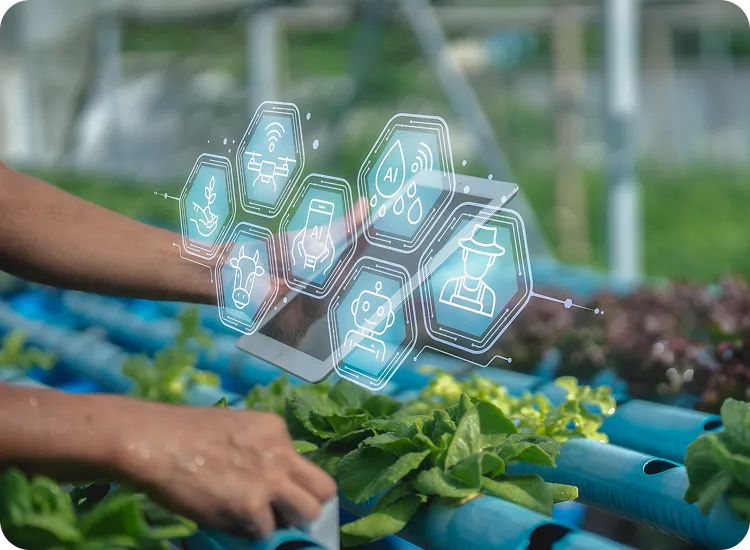
Planning and field actions become clearer with AI for farm management guiding agronomy priorities. Advisors spot trends sooner and focus interventions where outcomes improve most.

Controlled-environment data powers AI in smart farming to keep conditions stable and productive. Operators receive early deviation alerts and performance insights by zone and batch.
For farmers and agribusiness owners, operational blind spots create avoidable costs, delays, and waste. AI solutions for farming bring planning, execution, and performance visibility into one decision layer. So, teams coordinate faster, respond earlier, and run more predictable operations.
Daily work plans become clearer with AI for farm management, prioritizing tasks and assigning crews. Exceptions surface early through alerts, keeping field execution predictable.
Data becomes usable when AI software for agriculture runs on consistent records. Unified datasets reduce errors and power forecasting, alerts, and reporting across the business.
Demand signals and seasonality guide AI tools for agriculture to optimize inventory levels. Stockouts and waste drop as reorder points adapt to consumption patterns.
Visibility improves when AI for farm management predicts delays and bottlenecks across the supply chain. Teams coordinate harvest, storage, and delivery with fewer surprises.
Routing and scheduling improve with AI tools in farming, analyzing capacity and time windows. On-time movement rises while logistics costs fall through smarter load planning.
Purchasing becomes proactive when AI tools for farming forecast needs and highlight pricing variance. Supplier performance insights strengthen reliability and cost control across seasons.
Profitability decisions sharpen when AI software for farms connects costs to fields, herds, and lots. Forecasts and variance alerts help protect margins before issues grow.
Field variability becomes actionable with smart AI farming that recommends variable-rate inputs. Prescriptions export cleanly to equipment and workflows, improving consistency and efficiency each season.
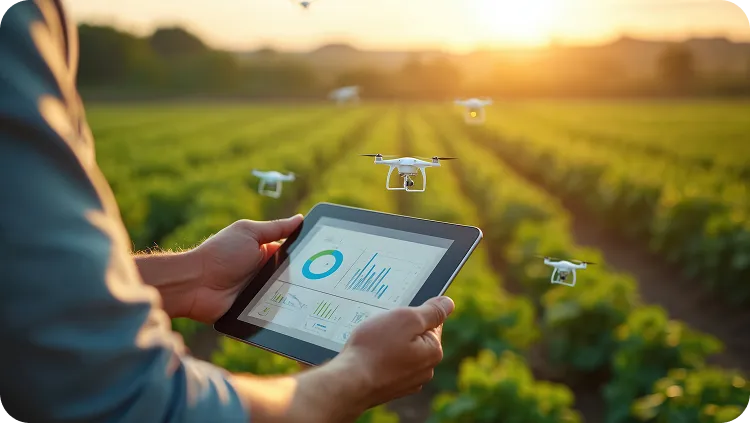
Powered by expert-driven agriculture artificial intelligence, we deliver trusted precision farming solutions that keep farms efficient, productive, and ready for tomorrow.
Practical adoption depends on more than models; it requires a stack that can collect, clean, learn, and deliver insights consistently. These technologies make AI solutions in agriculture deployable in real operations by improving data reliability, prediction accuracy, and day-to-day decision support.

Converts field images and video into measurable signals for monitoring crops, livestock, and facilities.

Forecasts outcomes and risks ahead of time, enabling proactive planning and smarter operational decisions.

Builds pipelines that unify farm data sources into clean, trusted datasets for analytics and AI.

Keeps models reliable in production through monitoring, retraining, versioning, and governance controls.

Categorizes visual patterns to detect disease, pests, stress, or anomalies with consistent accuracy.

Turns unstructured notes, logs, and documents into searchable insights and decision-ready information.
AI succeeds when it is grounded in the signals farms already generate across fields, herds, and operations. These data sources and tools make AI solutions in agriculture practical by improving visibility, enabling earlier detection, and supporting decisions that reduce waste and operational risk.
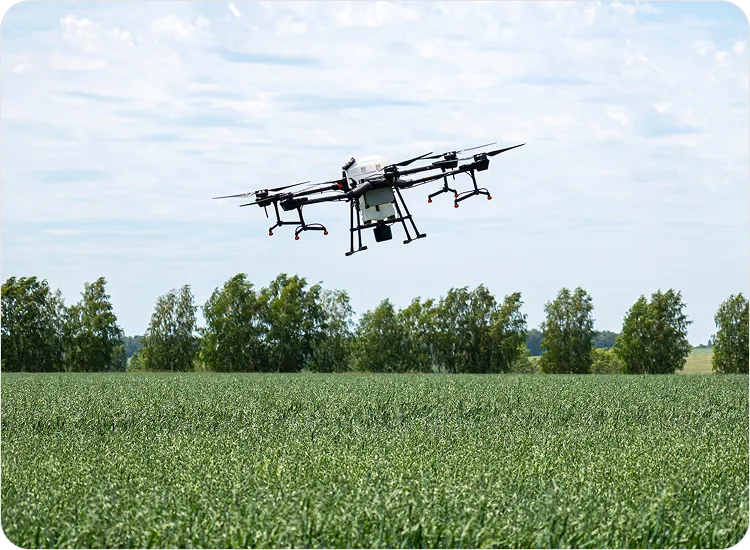
Deploying AI successfully requires more than models; it demands discipline, field validation, and operational fit. This process ensures AI tools are implemented reliably and adapted to diverse agriculture practices, so teams achieve measurable impact without disrupting day-to-day execution.
Work begins by clarifying the decisions you need to improve and the constraints you operate under. Success metrics are defined early to ensure measurable outcomes.
Data is assessed for completeness, consistency, and usability across your systems. Sources are mapped into a clean model to support reliable insights.
Models are selected based on your data, objectives, and operational environment. The focus stays on deployable accuracy, not experimentation.
A focused pilot is built to validate results with real users and workflows. Outputs are refined until they are trusted and actionable.
AI is deployed into the tools and workflows teams use every day. Alerts, tasks, and dashboards are designed to drive action.
Solutions are scaled across sites, seasons, and teams with governance in place. Continuous monitoring ensures models remain accurate as conditions change.
Apply AI tools and solutions for agriculture across crops, livestock, and the overall farm supply chain to detect risks earlier, improve planning accuracy, and strengthen operational execution.

See how leading businesses are using our AI solutions for agriculture to replace manual repetition with scalable, insight-driven automation.

To eliminate manual counting errors, Australia’s 2nd largest beef producer adopted AI-powered cattle counting via drone footage and implemented a real-time, computer vision monitoring system for livestock.
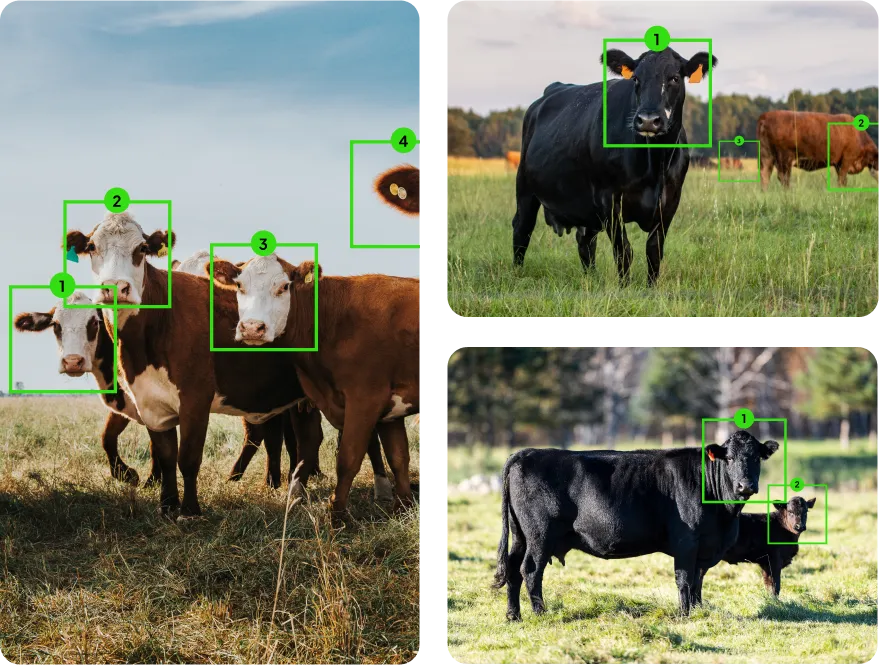
Two decades in agriculture means you don’t just need “AI”, you need solutions that respect seasonality, margins, and operational realities. Our experience combines deep ag insight with technical rigor, so teams can deploy trusted AI that fits workflows and delivers measurable impact.
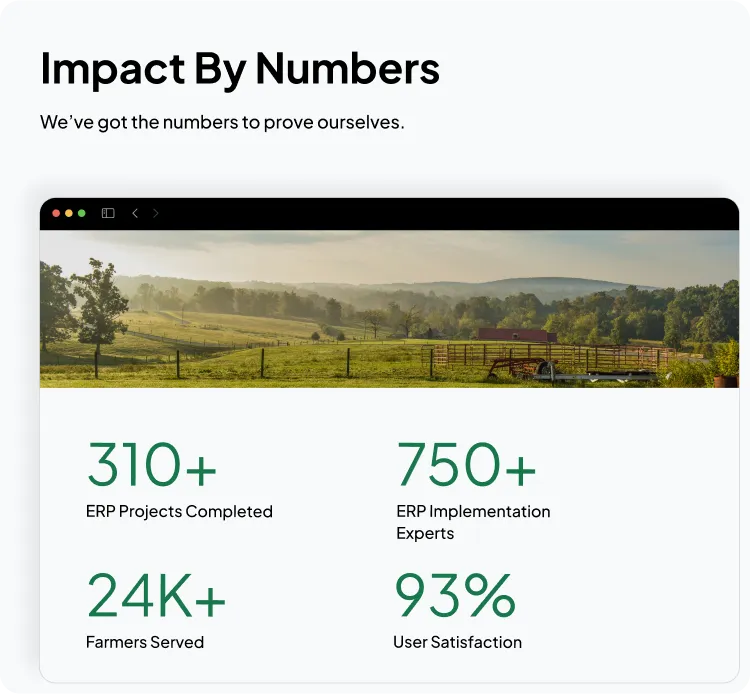
Read what our clients say about their experiences and the difference our solutions have made for them.
Vice President Information Technology
VP of Operations
IT Project Manager
Systems Administrator
Product Manager
AI and machine learning can identify early signs of disease in crops and livestock by analyzing images, sensor data, and historical health records. In crops, AI models process drone, satellite, or field camera imagery to detect leaf spots, discoloration, or abnormal growth patterns before they spread. In livestock, AI-powered monitoring systems track behavior, feeding patterns, and vital signs to flag early symptoms of illness, enabling faster veterinary intervention and reducing losses.
Recent innovations include multispectral drone imaging for real-time crop health mapping, AI-powered livestock facial recognition for health and weight tracking, and machine vision systems for automated grading of produce or carcasses. Advanced predictive models now combine weather, soil, and market data to optimize planting, harvesting, and herd management decisions, while robotics integrated with AI are handling precision spraying, autonomous feeding, and disease treatment at scale.
AI helps farmers make faster, data-driven decisions that improve productivity, reduce waste, and protect resources. For crop growers, it means early disease alerts, optimized irrigation, and yield forecasting. For livestock producers, it ensures better herd health, feed efficiency, and traceability. By automating time-intensive tasks and offering precise recommendations, AI reduces operational costs while enabling farmers to respond proactively to risks.
AI-powered sensors collect real-time data on soil moisture, nutrient levels, temperature, and crop growth conditions. By processing this information through machine learning models, farmers can detect early signs of stress, such as water deficiency, pest infestation, or nutrient imbalance, and take timely action.
Generative AI for agriculture uses advanced algorithms to simulate possible scenarios, generate optimized crop plans, or predict outcomes based on historical and real-time farm data. For example, it can create adaptive irrigation schedules, forecast disease spread patterns, or suggest the best crop rotation strategies for a specific field. By modeling multiple “what-if” situations, generative AI helps farmers make proactive and data-backed decisions, even under uncertain weather or market conditions.
Folio3 AgTech AI software for agriculture improves decision-making and productivity by converting raw farm data into actionable insights. It aggregates information from sensors, machinery, weather forecasts, and historical records, then applies AI models to identify trends, predict outcomes, and recommend optimal actions, whether that’s adjusting irrigation schedules, fine-tuning feed rations, or anticipating pest outbreaks.
AI-enabled drones benefit farms by providing aerial health monitoring of crops and herd surveillance for livestock. They can identify crop stress, irrigation gaps, or weed spread, and in livestock operations, they help track animal location, detect injuries or heat stress, and monitor grazing patterns, all without constant manual scouting.
AI optimizes inputs like feed, water, and fertilizer to cut waste and costs. For crops, this might mean precision irrigation or nutrient application. For livestock, AI can optimize feed efficiency, detect early signs of illness, and reduce methane emissions through custom diets.
AI models process imagery from drones or field sensors to identify early pest infestations by recognizing leaf damage patterns or pest presence. For yield forecasting, algorithms analyze weather, soil data, and crop growth stages to predict harvest volumes with high accuracy.
Most AI farming tools today are built for ease of use, but basic training is essential to interpret data and act on insights correctly. Folio3 AgTech provides hands-on onboarding, role-based user training, and ongoing support for both crop and livestock farmers, ensuring teams can confidently use the technology to its full potential.
Start with solutions that work with lighter inputs, such as AI-powered monitoring from imagery, weather-driven risk alerts, or simple forecasting based on historical records. These deliver early value while you build a stronger data foundation over time.
Effective AI tools in agriculture are trained and monitored with seasonality in mind, using historical patterns and continuous performance checks. It helps models stay reliable as weather, crop stages, and operational practices change.
AI crop monitoring goes beyond visualization by detecting anomalies, predicting risk windows, and prioritizing actions. Instead of showing maps only, it supports decision-making with alerts, recommendations, and trend-based insights.
Accuracy depends on data quality, image resolution, ground-truth validation, and how well the model is tuned to your crop and region. The most reliable outcomes come when AI is validated against field scouting and updated over time.
Yes. AI for remote crop sensing can run on satellite imagery alone, especially for field-level monitoring and variability detection. Drones improve resolution for specific diagnostics, but they are not required for many scenarios.
Field teams benefit from mobile workflows for scouting, task execution, and exception capture, while leadership benefits from dashboards, forecasts, and risk alerts. The best approach connects both so that field actions continuously improve the model.
ROI is proven through a focused pilot with clear baselines as tracking savings from reduced input waste, avoided losses, improved timing, fewer rework cycles, or better operational throughput. Scaling follows once the pilot shows repeatable impact across sites or seasons.

160 Bovet Road, Suite # 101, San Mateo, CA 94402 USA
6701 Koll Center Parkway, #250 Pleasanton, CA 94566
2 – 105 Consumers DR Whitby ON L1N 1C4, Canada
49 Bacho Kiro Street, Sofia, 1000, Bulgaria
Export House, Cawsey Way, Woking, Surrey, GU21 6QX
Amado Nervo #2200 Edificio Esfera 1 piso 4 Col. Jardines del Sol CP, 45050, Zapopan, Jalisco, Mexico
C/- Prime Partners Level 4 1 James Place NORTH SYDNEY New South Wales 2060, Australia
Folio3 FZ LLC, UAE, Dubai Internet City, 1st Floor, Building Number 14, Premises 105, Dubai, UAE
Folio3 Tower, Plot 26, Block B, SMCH Society, Main Shahrah-e-Faisal, Karachi.
First Floor, Blue Mall 8-R, MM Alam Road Gulberg III, Lahore
Corporate 7 by Maaksons, Executive Block, Civic Center 1, Gulberg Green, Islamabad
© 2026 Folio3 Software Inc. All Rights Reserved.
Get a Free Consultation Within 24 Hours, with a No-Obligation Ballpark Estimate
Error: Contact form not found.